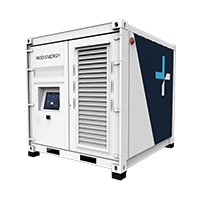As part of its commitment to the energy transition, Veolia, a world pioneer in this field, has tested a remarkable innovation: Charles, the autonomous charging robot for electric vehicles. This year-long experiment was carried out in two Veolia car parks, in Aubervilliers and Vaulx-en-Velin.
Find out about the experience of two of the key players in the project at Veolia.
The electrification of fleets, a paradigm shift that is driving innovation

Arnaud WILLING-SALLERON
Director of Fleet and Mobility at Veolia
The deployment of clean vehicles requires a paradigm shift and a complete ecosystem around the vehicle. We’re no longer just talking about the vehicle, but also the recharging solutions, and in particular the charging points.
Veolia’s trial of the Charles charging robot illustrates the need for constant innovation in all areas of mobility. It’s not enough to innovate with electric vehicles; it’s just as crucial to rethink the infrastructure that accompanies them. By simplifying the recharging process, Charles provides an end-to-end solution that facilitates installation and connection to the electricity grid, and complements traditional recharging offerings.
Charging with Charles, a technological and practical innovation
Flexible autonomous navigation

Victor CSALI
Mobility Project Manager at Veolia
The Charles robot solution is above all an innovative one. With Charles, it’s no longer the vehicle that comes to the charge point, but the charge point itself that comes into contact with the vehicle.
The technology embedded in Charles means that this charging robot can navigate to the vehicle completely independently. Drivers don’t have to search for an available charging point. Car park managers do not have to over-equip spaces with charging points, allowing all users to park without dedicating too many spaces to electric cars.
Lightweight infrastructure and a solution to car parking problems
The infrastructure required for the solution to work properly is fairly light: the power demand is lower and the works budget is lower than for a more conventional recharging point infrastructure. It’s also a solution that will enable us to deal with the problem of car parking.
Victor CSALI
The Charles robot draws its power from a recharging base, connected to a power supply equivalent to a single terminal, and then distributes the energy stored in its second-life batteries to electric vehicles. The aim is to optimise the energy distributed, with positive repercussions for the environment and energy savings. In addition, the project demonstrates the possibility of reducing infrastructure costs compared with traditional recharging stations. Charles has been operational for over a year at Veolia car parks in Aubervilliers and Vaulx-en-Velin.

Use that raises awareness of the reality of electromobilists’ daily energy needs
The Charles robot is a fantastic way of teaching our employees about recharging. This digital approach of using an application to order the right recharge is also a way of raising users’ awareness of the right recharge, at the right time, for the right need.
Arnaud WILLING-SALLERON
The fact that the robot only delivers the energy that is really needed and requested by the end user is very interesting, because it shows our drivers that it is not always necessary to leave with a 100% recharge.
Victor CSALI
In addition to its primary function, Charles has also served as a vehicle for stimulating discussion and interest in recharging and electric mobility within Veolia.
“The robot has the important advantage of creating an image and positively involving our employees in recharging an electric vehicle”, adds Arnaud WILLING-SALLERON.
In conclusion
“We were delighted with this highly rewarding collaboration on both sides. Even if it has now come to an end, I think it opens the way to new exchanges and collaborations, whether on a robot or other technologies that will help us in the future to optimise the charging of our electric vehicles.”
Arnaud WILLING-SALLERON
Through this year-long experiment, the Véolia and Mob-Energy teams succeeded in gaining a better understanding of user behaviour and their needs. It was also an opportunity to make an in-depth assessment of the robot’s capabilities and performance, under a variety of conditions. It was a valuable learning experience for everyone involved, and one that will enable Mob-Energy’s development teams to continue developing the robot, in order to deliver an optimum experience and efficiency.
Your customized project
Every parking lot is different.
Every customer has his or her own recharging needs.
That’s why our solutions are modular and scalable, so that your recharging infrastructure is perfectly suited to your needs at all times.





